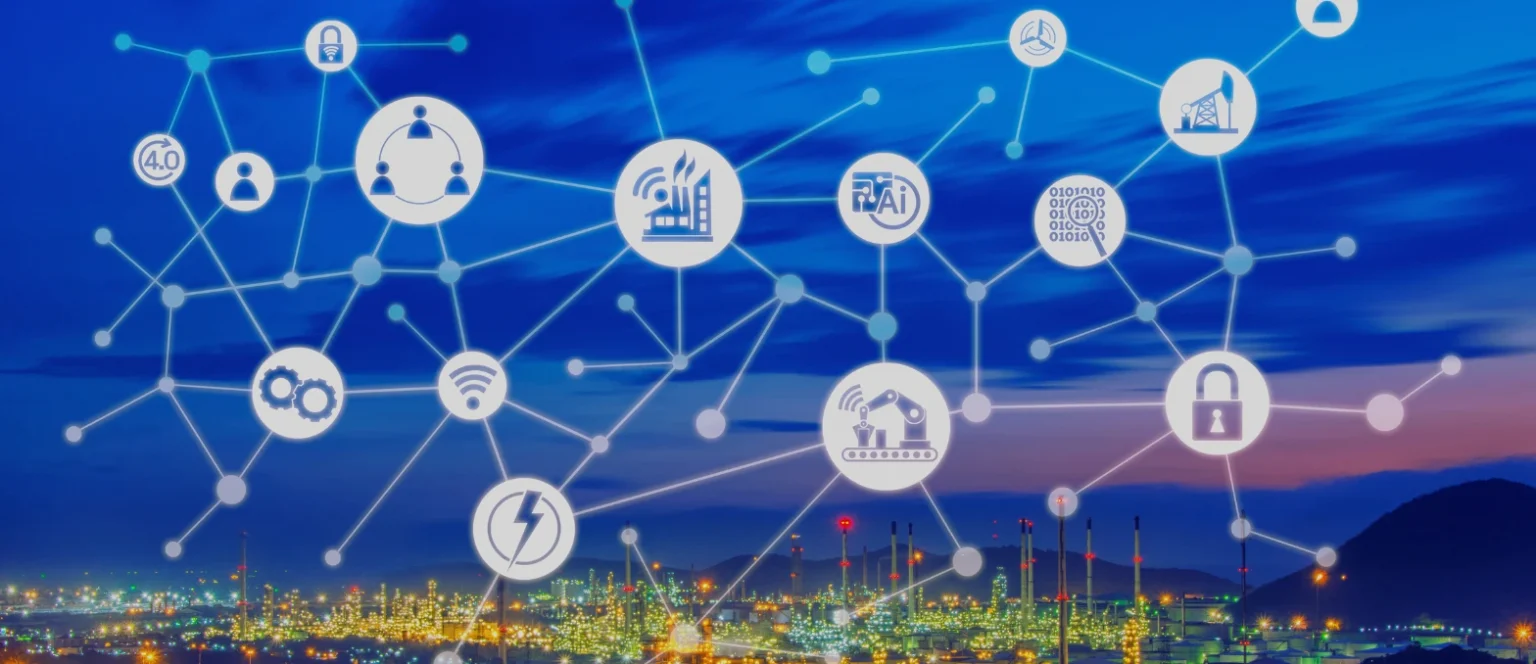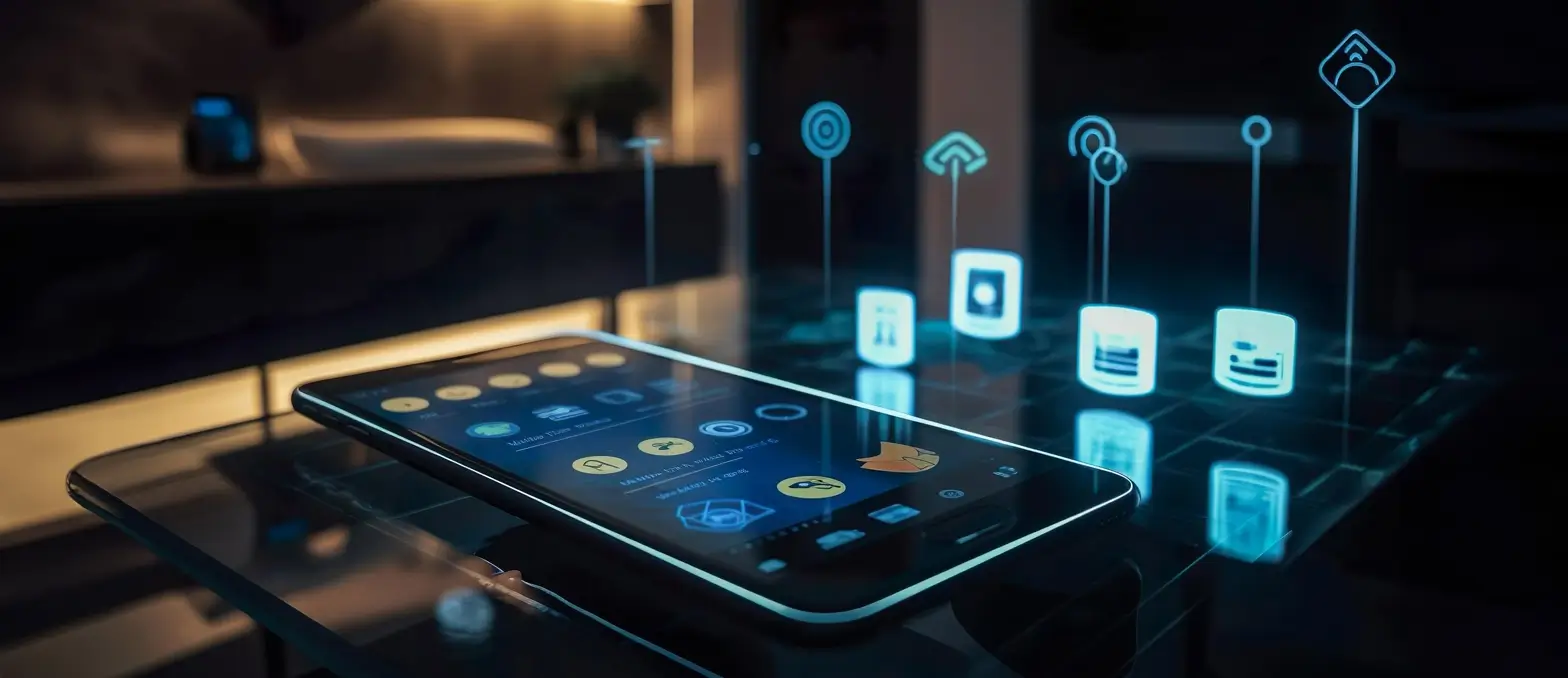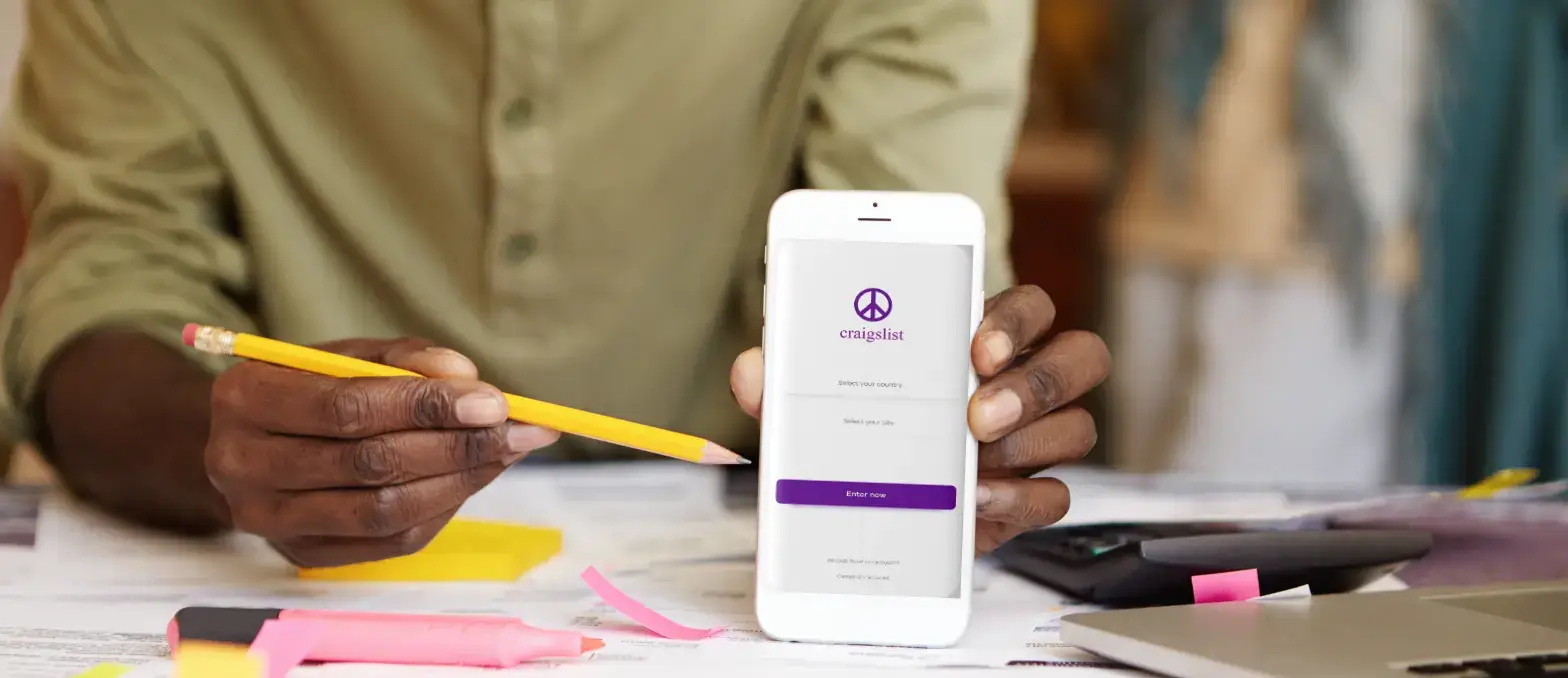Table of Contents
Telemedicine is transforming the healthcare industry by leveraging technology to connect patients with healthcare providers seamlessly. With the increasing demand for remote healthcare services, building a telemedicine app in 2025 presents a lucrative opportunity for businesses and developers. This guide will walk you through the essential steps, features, and technologies required to create a successful telemedicine platform.
Telemedicine applications make use of innovative technologies such as secure messaging IoT, real-time healthcare data management, collection and video conferencing to enable virtual consultation between medical experts, regardless of geographic borders.
It’s not surprising that the genre of app is attracting the curiosity of potential investors.
However, the majority of them are uneasy because of the many things to be able to comprehend. Because telemedicine apps handle important patient data and data, they have to be in compliance with many rules and regulations. But that’s not all there is to it. You must decide on the kind of features, features, technology stack and telemedicine app.
In addition, you need to take into consideration the price and carefully consider the investment alternatives. In essence, you have to take your time and proceed step-by-step cautiously. This article aims to make the process simpler for you by providing the various aspects of developing a telemedicine application, right from the types of apps, features, through developing steps and issues. Let’s begin with the most frequently asked question.
What Is A Telemedicine App?
A telemedicine application is a healthcare software application that allows rapid and easy access to healthcare services and users on mobile devices. Telemedicine applications provide patients with a secure way to communicate the medical information of their patients, talk with their physician of choice and get a quick diagnosis.
As per top iOS app development companies, Telemedicine apps encompass a broad array of services. These services promote virtual health experiences. One of the greatest advantages for these applications is their capacity to deliver health care services remotely.
This is particularly helpful for those who live in areas with a remote location and who have restricted access to medical facilities. Through a telemedicine application, patients can consult with medical professionals from at-home comfort of their homes, without having to travel far or wait in long lines.
The applications are also popular because it makes routines that are not urgent such as regular health check-ups and subsequent visits. However, it also provides immediate medical assistance in emergencies through the establishment of rapid communications and giving immediate access to medical experts which could save lives during crucial situations.
What Are The Types Of Telemedicine Apps?
It is possible to leverage the telemedicine app solutions and tools and change the way healthcare is delivered using digital channels, by transforming the conventional processes using digital benefits that are available, or referred to in the general sense in store and forward technology, remote monitor and real-time interactive techniques. Integrating these functions into your mobile telehealth app allows you to create an interoperable health system. Let’s look at them along with the other four telemedicine applications in greater depth below.
Store And Forward (Store And Forward Telemedicine Examples)
Store and Forward is a telemedicine method in which medical data, like videos, images or patient data are stored and saved for later transfer to an expert or healthcare professional. When developing a telemedicine application the forward and store functions lets users upload and transmit medical information to healthcare professionals to review and analyze it quickly.
Remote Monitoring
Telemedicine is a term that is the ability to monitor health status of patients remotely, often via sensors, wearable devices, or other devices connected to the internet. These devices record data on vital indicators, activity levels or other pertinent health indicators, which is then passed on to healthcare professionals to analyze and monitor. As part of the telemedicine application design, the remote monitor is linking these devices to the application to allow continuous or regular data transmission.
Real-Time Interactive
The ability to interact in real-time within the telemedicine application allows for instant interactions between healthcare providers and patients. It lets you participate in online video chats and instant messages or audio calls that simulate an in-person consultation and the convenience via remote connection. With live-time interactive capabilities patients can communicate with health professionals in real-time to discuss their health issues, get medical advice and even take part in virtual exams. This kind of telehealth application was extremely well-liked in the Covid19 period and was widely used among both healthcare providers and patients.
Tele Neuropsychology
As per mobile app development company in USA, Teleneuropsychology can be described as the use of visual and audio technologies that allow remote clinical encounters for neuropsychological examinations. Teleneuropsychology (TeleNP) can be described as one of the most rapidly growing and promising practices in the field of telemedicine. Teleneuropshy is accepted as a telemedicine option by both practitioners and patients, with 98% satisfaction for adults.
One of the most successful applications for tele neuropsychology is Cliniclive (web application for practitioners as well as a mobile application for patients) assists in offering neuropsychological consultation to patients via video conferencing to conduct standard tests as well as diagnosis, treatment and follow-up.
Telenursing
Telenursing is a different sector of telemedicine that connects nurses and patients via remote nursing services. This kind of application is growing in popularity with those with chronic illnesses, as well as caregivers who require constant and continuous monitoring. Telenursing app development is aiding healthcare institutions to dramatically reduce the costs of nursing as well as increase the value of nursing.
Telepharmacy
The market for telepharmacy is anticipated to grow by 25.3 percent over the 2022-2027 forecast timeframe. Following the Covid 19 outbreak, telepharmacy applications helped reduce the risk for exposure to infectious diseases. They are widely used by doctors and patients for prescriptions for pharmacology. These programs help patients manage their medications via phone or video-based consultations.
Telerehabilitation
Telerehabilitation is a third telemedicine option that makes use of cutting-edge technology to communicate with patients as well as perform therapeutic assessments and clinical trials. Webcams and videoconferencing are the most commonly used tools for communicating clinical and medical progress. Telerehabilitation apps are developed to provide tools and functions that facilitate evaluation of, monitoring, assessment prevention interventions, supervision education consulting, and coaching.
There are many Telemedicine applications available to doctors and patients to utilize to provide efficient and effective medical needs. These applications offer more numerous options to get the medical care that patients require.
Why Is Even A Telemedicine App Required?
While the global pandemic may have disappeared, its footprints are still visible in the way people are of remote access or social isolation. Therefore, enterprises in healthcare are working to improve the patient experience for people in the digital age. Patients, practitioners as well as providers, are demanding digital-friendly services for interaction with patients.
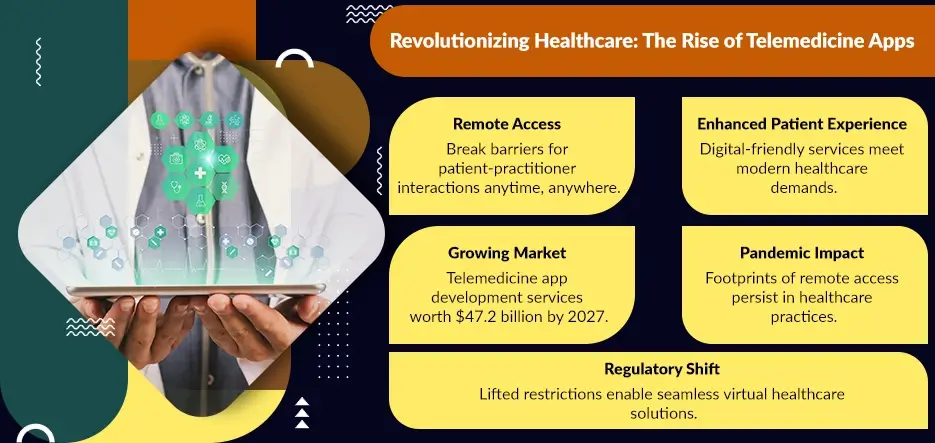
Based on Statista The estimated market of telemedicine app worth of EHRs in 2027 is expected to rise to 47.2 billion U.S. dollars which was 29 billion U.S. dollars in 2020.
Restrictive regulations and reimbursement guidelines were one of the main obstacles to moving to the new system and the services. However, the situation has drastically changed since these restrictions were lifted after Covid19 was introduced, and the regulators urged healthcare organizations to speedily be ready to meet the requirements of providers to treat patients even if clinics in person were shut down.
Statista in its report, also noted the steady growth in acceptance of telemedicine in Americans and estimates that the market will grow to the 280 billion dollar mark in 2025.
3 Common Healthcare IT Integrations Crucial For Telemedicine App
Integration is nothing more than linking two or more healthcare IT systems in order that they work optimally and serve the purpose that it was intended to serve. One of the main reasons for integration is the fact that healthcare IT integrations are necessary to exchange critical information and improve efficiency of operations and cut down on overall costs and time spent in healthcare. Let’s take a look at the most popular medical IT integrations.
EHR And EMR Integration
As per top mobile app development companies, integrating a telemedicine application to EMR as well as EHR systems is an essential aspect to take into account, as it could enhance the quality of healthcare and boost the efficiency of the medical profession. EHR as well as EMR connection with telemedicine apps or telehealth applications allows interoperability across healthcare systems as it facilitates two-way workflow between the systems. Henceforth, doctors can utilize a single system to store workflow records instead of storing them in multiple systems. A telemedicine application that has EHR or EMR integration can bridge the gap between the telemedicine applications and patient information. It assists providers with quicker diagnosis, and lower errors in prescribing and helps with the use of science-based decisions.
IoT And Wearable Device Integration
Because telemedicine apps are intended to provide healthcare assistance on demand. Integrating telemedicine into IoT or wearable gadgets ensures the continuous flow of health information. It allows patients to play an active part in their own health management. The app also facilitates remote monitoring of patients, allowing health professionals to keep track of the patient’s health and intervene if needed.
Hospital Management System Integration
The third and last integration your telehealth application requires is the hospital management system. If you’re planning to invest in the development of telehealth software to improve your hospital’s and efficiency in healthcare, integrating a hospital management system to your telehealth app allows you to access the latest operational management data on a mobile device. If it’s providing real-time updates of patient information, the seamless coordination of care, effective appointment scheduling as well as billing and docs, you can improve the experience of telemedicine and the virtual experience by implementing an integrated approach to ensure the best quality in healthcare delivery.
List Of Popular Telemedicine Apps Has Revolutionized Virtual Healthcare
When you hire telemedicine app developers, you are thinking how you must design your app. There are a variety of telemedicine apps on the marketplace, all having distinctive advantages and features. The top applications for telemedicine on the market are:
Teladoc: Teladoc is a telemedicine program which allows patients to connect with doctors using video conferences. Patients can make use of the app to make appointments, get medical advice and get prescriptions for medications.
Doctor On Demand: Doctor On Demand, a telemedicine program which allows patients to join doctors via video conference. Patients can utilize the app to get medical advice or even prescriptions for medicines.
Amwell: Amwell is a telemedicine program that lets patients communicate with their doctors via video conferences. Patients can make use of the app to make appointments, get medical advice and get prescriptions for medications.
Who Needs To Invest Into Telemedicine App?
Based on the information supplied through Market.us, the telemedicine market on a worldwide scale was worth USD 63.5 billion by 2022. It is expected to experience significant growth and is expected to hit USD 590.9 billion in 2033. The forecast timeframe of 2023-2032 is predicted to show a compound annual rate of growth (CAGR) that is 25.7 percent.
Certain statistics also demonstrate the growing demand and growth for an improved remote medical experience.
- Mobile and Web will be considered to be the primary delivery medium in 2022.
- North America dominated the market with the highest share of revenue of 36 percent in 2022.
- Asia Pacific is expected to expand at the fastest CAGR in the forecast timeframe.
Therefore, telemedicine app solutions are a lucrative option for entrepreneurs as well as enterprise healthcare organizations looking for more revenue stream opportunities, while improving the quality of healthcare and services, and improving efficiency in operations while reducing the overall cost. The two most prominent players who are looking to invest in the development of a telemedicine app are entrepreneurs and health care providers in the enterprise. Let’s look at what healthcare providers could benefit from telehealth app services.
Entrepreneurs
As per Android app development companies, each telemedicine application on the market is designed to help bridge the gap between patients and healthcare providers in order to deliver high-quality solutions. Because telemedicine hasn’t been fully explored and plenty of digitization and renovation are still to be completed You can begin your own business venture by launching an app which solves the current issues. It is possible to start by creating an application for telehealth with basic capabilities and then expand as demand exceeds. Telenursing or telepharmacy EHR/EMR, the customer-focused fitness app, hospital information management software or a comprehensive wellness platform, you can identify the gaps in the market and begin your entrepreneurial journey. You could choose to use the option of venture capital and an app-based monetization plan depending on the characteristics of your app to be an award for your idea.
Enterprise Healthcare Institutions
As telemedicine becomes more and more popular, and the need for virtual healthcare increases, having the ability to use telemedicine apps could give the enterprise healthcare provider an edge in competition. If you’re among the key decision makers from an enterprise-level healthcare organization You might think about investing in the development of a telehealth app to facilitate continuity of care, by encouraging virtual follow-up visits as well as ongoing monitoring of patients to increase the patient’s engagement. In addition, the integration of a telemedicine application in an existing healthcare setting can allow you to expand access and availability of healthcare to a wider range of patients, which will boost your market share, reduce money and boost efficiency.
Are you interested in knowing the exact effects of developing a telehealth app for your company’s healthcare facility? Get in touch with our experts today.
What Do You Need To Know First Before Stepping Into Telemedicine App?
While there are many advantages for both the patients and businesses developing software for telehealth, it is a difficult task that requires you to be prepared with the appropriate information. Let’s look at them in greater detail as specified by the top custom mobile app development company.
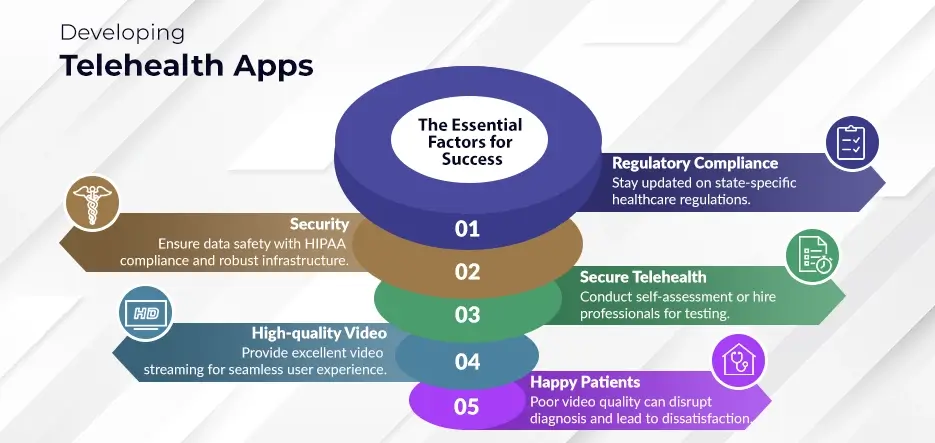
Regulatory Compliance
The information about patients’ healthcare is vital information for every state. Since telehealth apps deal with sensitive information of patients’ data, it is essential to become familiar with all regulations and compliance requirements of the state where you intend to build the app for. Here’s a list of the regulatory requirements (country-specific) which you need to keep in mind when developing your telehealth application accordingly:
- HIPAA (United States)
- Conforming to PIPEDA (Canada)
- Data Protection Directive 1995/46/EC and the e-Privacy Directive 2002/58/EC/IEC 62304 (Europe)
- GDPR (United Kingdom)
- IMLC (Columbia)
Security
In addition to developing an HIPPA-compliant app and ensuring that you have a comprehensive infrastructure, you should be aware of security and data security both during transit and in rest. Tools or algorithms and protocols like AES 128 Bit as well as SHA 256 can be leveraged to develop telehealth apps. Although you have the right protocols in place and the appropriate tools, security could be compromised in the event that a user is not careful when using the app. To ensure that your virtual health application is safe to be used by users in every way and in all ways, you can increase the process through self-assessment. Or by hiring a professional penetration and vulnerability testing, along with high-quality engineering services to detect potential vulnerabilities or bugs and rectify them prior to the application launches.
Video Quality
As per on demand app development company, High-quality video streaming is an essential requirement for all types of applications that use telemedicine. As patients use mobile telemedicine apps to consult with video, poor quality video could affect the user experience, and lead to an unhappy patient. Poor quality video streaming could cost businesses as it can disrupt the diagnostic process. So, make sure that your app’s video quality is excellent regardless whether it’s on a mobile or a desktop. In addition to the quality of video streaming of the mobile application, it must also be compatible with web applications that are used by doctors. Applications that require costly or new technology are not well-received by many.
How Much Does It Cost To Build A Telemedicine App?
The development of a telehealth application with basic features could cost you around $40,000-$55,000. But, a fully-fledged and advanced telemedicine app costs between $90,000 and $200,000.
Trending Technologies Influencing The Growth Of Telemedicine Apps
The world of healthcare, thanks to the aid of telemedicine applications, is no longer a geographic or logistical issue. The advancement of technology, such as hosting, development techniques and innovation that is focused on the customer has allowed us to turn virtual healthcare into an entire solution. Let’s take a look at some most popular technologies that are driving the growth of telemedicine applications.
Artificial Intelligence (AI)
Artificial Intelligence or AI allows applications for telemedicine to provide advanced features like natural processing of language for voice recognition and chatbot interaction such as pattern and image recognition for diagnosis support and predictive analytics to provide individualized patient treatment. AI algorithms are able to analyze huge volumes of patient information to identify patterns, diagnose accurately and make treatment recommendations.
Internet of Things (IoT)
Wearables and other IoT devices such as remote monitors for patients are able to transmit real-time patient information to telemedicine applications. These data include vital indicators such as activity levels, medications, and other health-related data. Integrating IoT application development for telemedicine permits healthcare professionals to observe patients at a remote location, deliver prompt intervention, and offer customized care based upon continuous data gathering.
Cloud Storage
Cloud-based healthcare solutions provide secure and large-scale storage of patient records in telemedicine applications. Healthcare providers can safely be able to access patient data as well as scan results as well as treatment plans, anywhere and at any time. Cloud storage enables the seamless exchange of data between health professionals which improves coordination of care as well as facilitating remote consultations.
Blockchain
As per healthcare app development company, blockchain technology provides increased security and privacy for the development of telemedicine apps. Blockchain technology provides the safe sharing and storage of health records while also protecting sensitive data from access by anyone else. Blockchain also allows safe and auditable transactions including confirming consent to share data and managing payments and billing for telemedicine. With blockchain-based app services healthcare professionals can ensure the highest level of security and trust for their telemedicine apps.
Big Data
Telemedicine applications generate and accumulate huge amounts of patient information which includes medical documents, imaging data along with real-time data from monitoring. Large Data analytics tools are able to analyze and process this data to discover patterns or healthcare app development Trends and provide insights that aid in clinical decision-making, enhance the management of health in the population as well as enhance research in telemedicine.
Deep Learning
Advanced algorithms for deep learning, which are a part of AI that can be used in telemedicine applications to analyze medical images, like images from X-rays, CT images, or pathology slides. These algorithms aid healthcare professionals in diagnosing ailments by identifying the presence of abnormalities and offering treatment suggestions. Deep learning improves the efficiency and accuracy for image-based analysis which can aid in remote diagnosis, and decreasing the necessity for consultations in person.
Chatbots
Chatbots that integrate into telemedicine apps provide support and assistance for patients. They can help with common medical queries, provide details on symptoms or medication as well as schedule appointments and triage patients according to their symptoms. Chatbots can improve engagement of patients and provide support 24/7, and lessen the workload of healthcare providers through the handling of routine queries.
What is Process?
The Telehealth application process starts by gathering engineering requirements, software design, then deciding on the features of telehealth apps and developing a model for development, choosing the most appropriate tech stack and then launching and updating according to feedback from users. Let’s look them over and learn about their importance in the development of a successful software for telehealth.
Step 1. Requirements Engineering
Telemedicine app is the very first phase of creating an app. The Healthcare app development companies assists you with research on market and competitor analysis before you make the app a commercial product. If you’re from a healthcare institution, a business analyst from telehealth will assist in determining the requirements of the business and the elicitation of requirements for software.
This process can also help to identify other important aspects of creating an app, for instance taking into consideration the standards and compliance you might need to adhere to in the context of how your app is operating. For instance, you might require your app to be structured to conform to HIPAA regulations to be able to operate in the USA. It is possible to choose additional elements that you need to incorporate into your application to enhance its functionality. Budget planning is an important aspect you will need to decide on in this phase to establish an understanding of the scope of developing a telemedicine app.
Step 2. Project Planning
Planning the project is an essential step in the process of developing apps as it aids in determining the scope and goals of app development. You will be able to determine the functions, features and goals and determine the allocation of resources like budget, time, and developers that are essential to ensure an efficient project’s progress.
In this stage you must also choose how to manage time and SDLC procedures, if you want you prefer agile or DevOps. Also, you can incorporate Scrum and Kanban for complex projects which require flexibility in the team. The next step is quality assurance, because you need to make sure that the app you develop is of quality. By setting standards for quality, methods for testing, and incorporating quality assurance tasks into the overall plan of development. It is possible to continuously examine and validate the app’s performance, functionality security, as well as the user experience. This helps to deliver an application of the highest quality that meets the requirements of both users and the other parties.
Step 3. UX And UI Design
When creating an app for telehealth it is vital to understand the primary scenarios that users will encounter, such as appointment scheduling via video or prescription renewal. This is followed by visualizing the fundamental functionality that the app must provide. This includes features such as patient-doctor messages and tracking of vitals. Furthermore, mapping routes for users, doctors, nurses, and administrators will ensure an easy and enjoyable experience for everyone affected.
To give a concrete illustration of the design, UI prototyping techniques are employed which allows users to envision how the telehealth application will be designed and operated. A key element of the development process is UI design. Where appealing graphics are used to improve the overall design and user-friendliness of the application. Telehealth applications are able to be optimized by following these steps to satisfy the needs of users. And offer an appealing and user-friendly platform for health interactions.
Step 4. Decide Features
Audio and Video Conferencing
- Let patients and healthcare providers connect and monitor the health of patients.
- Care instructions for the patient.
- Examine details of medical histories and take tests in real-time.
Video and Image sharing
- Send any medical records or video footage of an area that is affected.
Text Messaging
- This medium of communication can be employed in cases of inadequate internet connection.
- Patients and healthcare professionals to be able to communicate at their preferred time.
Self-assessment
- A dashboard that can help patients manage their health efficiently
Step 5. Decide App Building Method
You can build your app for telehealth using three different ways to best meet your requirements.
Native App Development
The development of native apps permits you to provide better features. However, you must create the app’s code in a separate way which takes time and adds to overall development costs. If you’ve made a significant capital expenditure and a strong plan to reach the world market. Developing native mobile apps for telehealth applications is the ideal choice
Cross-Platform App Development
Cross-platform application development lets you develop and maintain a single codebase, and run mobile applications across different platforms. It reduces time and money, but is slower than native applications. Cross-platform custom mobile app development services is the best option when you are able to compromise certain extent in terms of the functionality and performance, and you don’t have huge capital.
MVP App Development
One of the most effective and most popular ways for an app to go to market faster is creating it using an MVP method. MVP development will require low capital, but shorter time to launch the app on the market. The process of MVP development means that you launch the app with key features and functions for the early stage users. Based on the honest feedback of users the apps can be improved and expanded with new features. Functionalities as well as other requirements that are more sophisticated. Airbnb, Dropbox, Amazon and Facebook are just a few of the most successful examples of MVP application development.
Step 6. Decide Technology Stack
| Category | Technologies |
|---|---|
| Frontend | Swift/ Java and Kotlin, HTML, CSS, JavaScript, Flutter, ReactNative and many more |
| Backend | PHP/NodeJS/Python |
| Database | MySql/MongoDB/Postgresql |
| Cloud Server | Amazon AWS, Azure, Google |
| SMS | Twilio |
| Geolocation | Google Places APIs |
Step 7. Launch And Maintain A Telemedicine App
The role of a developer for telemedicine apps isn’t over once the app is created. It is also possible to seek professional assistance when launching the app on the appropriate platform. And further enhancing it for more user-friendliness and performance as the number of users increases.
Telemedicine App Team Composition
Be aware that it’s not just software developers that you require as your extended team for developing your telehealth app. You will require a full IT department to be your backend team to create and launch your app. So, the team’s composition will look as follows:
- Frontend Developer
- Backend Developer
- UI/UX Designer
- Business Analyst
- Project Manager
- QA Engineer
- DevOps Engineer
- Team Lead
One of the advantages when working through a telecommuting application development firm is the possibility of hiring the experts you require with any level of knowledge from them on a needs basis. These healthcare digital transformation companies can be your go-to source for hiring resources on-demand, and then scale them down as needed.
How Success Can Help You Build a Telemedicine App in 2025?
In the past 20 years, we’ve been able to provide a variety of healthcare services. We have experience working with conventional medicare services, we mix practical expertise with innovative projects that ensure interoperability and efficiency. In the aftermath of Covid19, we also helped modernize and transfer EHR systems to cloud-based platforms for remote monitoring and consultation solutions. Alongside this we also assisted in the development of a complete telemedicine software from scratch. With a short turnaround time that improved outcomes for patients and care.
Yes we have a group of IT professionals who are focused on healthcare comprising UI/UX designers, web and application developers as well as business analysts, compliance specialists, QA engineers, DevOps specialists along with project managers who have extensive expertise. To improve the value of the development of your telehealth mobile apps. We can assist you with consultations specific to healthcare and competitor analysis, functional testing as well as feature and usability-related decision-making. Full-stack development as well as deployment and development using DevOps as well as other.
Conclusion – How to Build a Telemedicine App
Telemedicine is the next generation of digital healthcare. Because patients and healthcare professionals are more prone to digital healthcare services, from basic and advanced health care options. Health tech solutions are required to revolutionize and transform the way we think about traditional healthcare solutions and services.
Therefore, it’s the perfect time to work with a company that develops apps for telemedicine and put your healthcare apps Like Zocdoc on handheld devices to the people you want to target.
FAQs – How to Build a Telemedicine App
How to find the right company?
You need to check with the experience, portfolio, costing, and developer skills to reach the best app company. If you are still looking for one for white label app development, then A3Logics can assist.
How much does telemedicine app building cost?
To build a telemedicine application with basic features could cost you around $40,000-$55,000. But, a fully-fledged and advanced telehealth application will cost between $90,000 and $200,000.
Is A3Logics providing 24/7 support?
Yes, you can connect with the experts at A3Logics for any queries related to telemedicine app any time. Good luck!


